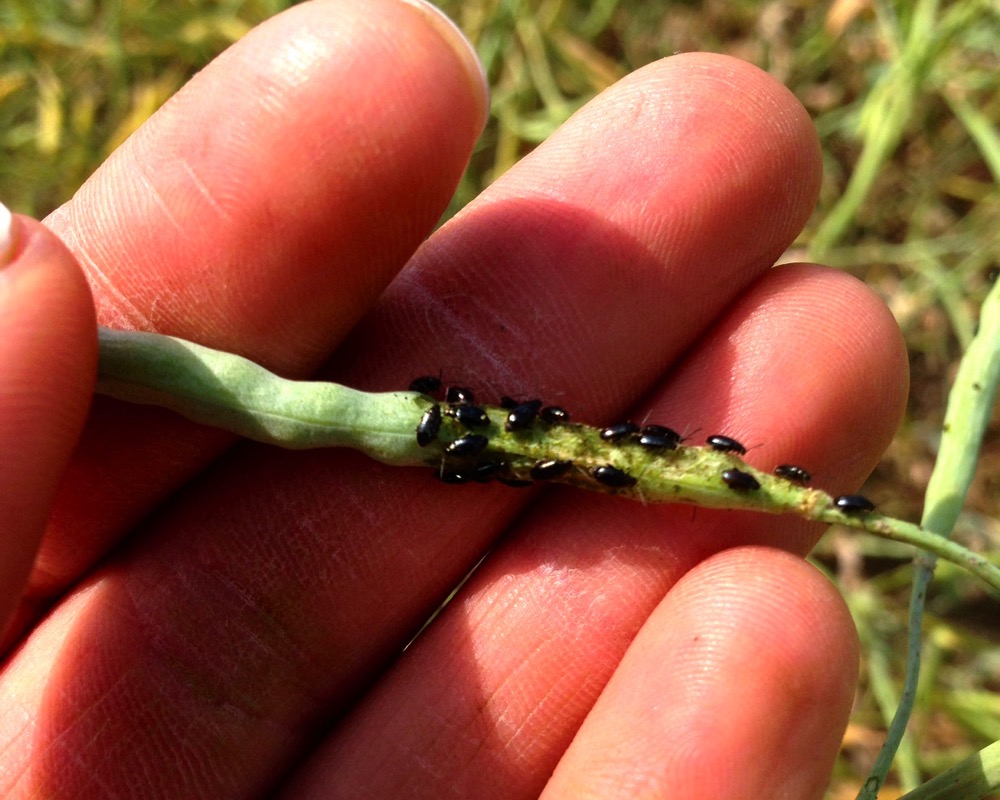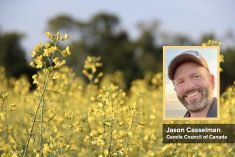The new generation of adult flea beetles was thick on canola fields in August, nibbling pods and capping off what had been a busy year for the costly insect pest.
Bob Elliott, integrated pest management scientist with Agriculture and Agri-Food Canada (AAFC) in Saskatoon, saw a fivefold increase in adults captured in sticky traps in summer 2015 compared to summer 2014. This was on top of a significantly higher spring population.
Late-summer feeding is not usually an economic concern, even with big numbers, but the sight of these clusters had Canola Council of Canada agronomists wondering what 2016 will bring. Flea beetles that hatch and grow into adults through the summer are the generation that overwinters and emerges in the spring looking for young canola plants to eat.

“Flea beetles are the most important — the most costly — insect pest in canola, with just about every acre getting protection through seed treatment and a percentage of those same acres also getting in an in-crop application,” says CCC agronomy specialist Keith Gabert. “The in-crop protection decision seemed especially common in 2015, with widespread cool and dry spring conditions that delayed crop establishment and left the crop vulnerable for longer.”
The Canola Watch agronomy e-newsletter regularly addressed the heavy flea beetle situation during crop establishment in May. Slow emergence or delayed emergence due to dry soil, cool temperatures and repeated frost stretched the length of time plants needed protection from flea beetles. Unthrifty plants were extra vulnerable. Many fields needed to be reseeded, and many others with just enough plants to make it through had to be sprayed.
Read Also

Agronomists share tips for evaluating new crop products and tech: Pt. 3
With new products, new production practices and new technology converging on the agriculture industry at a frenetic pace in recent…
“Lower populations of surviving plants meant growers had to pay closer attention to thresholds and were more likely to spray this year to protect that minimum stand,” Gabert says. “So with the high summer population, what will growers face in 2016?”
Entomologists are careful not to read too much into fall numbers. Past research did not show a strong correlation between fall numbers and the spring threat. However, Alejandro Costamanga at the University of Manitoba is leading a Prairie-wide grower-funded research collaboration focused on an integrated approach to flea beetle management. This research will provide improved economic thresholds for flea beetles in different ecozones, identify natural predators, and develop predictive models based on overwintering flea beetle populations, weather and other variables. The researchers believe advances in genomics and data analytics may make this modelling realistic. Results will not be available for 2016.
Plan for 2016
Best management practices for flea beetles remain seed treatment, followed by good agronomy to provide a minimum stand of seven to 10 plants per square foot, and in-crop scouting up to the four-leaf stage to see if foliar insecticide is required.
Even though current seed treatments are not as effective on striped flea beetles as they are on crucifer flea beetles, seed treatment is still an important investment, Gabert says. “And I can’t emphasize enough the value of a well-established stand. A fast-growing even stand is one of your best defences.”

Seed treatment and rapid, even stand establishment set up the crop to withstand most foliar flea beetle feeding that may occur. Thin stands, delayed emergence, and stress such as cool and dry conditions increase the likelihood that a foliar application is needed.
“I don’t know if there are currently any better ways to manage flea beetles than what canola growers are typically doing,” says Manitoba Agriculture, Food and Rural Development provincial entomologist John Gavloski. “Assessing defoliation to make spray decisions can be tricky, and damage can progress very quickly when weather is hot and calm and flea beetle populations are high. So management strategies that may reduce the need for foliar insecticide applications would be welcome.”
Hopefully in the future new strategies such as incorporating resistant varieties or enhanced control through natural enemies could be part of the management program, Gavloski says.
Flea beetle management in the future
“We do have new management tools in development that will further help growers with flea beetle management and we hope to bring some of those to market in time for the 2017 planting season,” says Ted Labun, Western Canada seedcare technical lead for Syngenta, the company that makes Helix seed treatment.
Elliott and his team at AAFC have been field testing new chemistries currently under review by the Pest Management Regulatory Agency (PMRA) and are preparing three scientific papers that will be submitted for publication once the products are registered. The papers will describe seed treatments and mixtures that provide the best control, protection and agronomic improvements when crucifer and/or striped flea beetles are a problem. They will also describe the impact of temperature and soil moisture on the efficacy of the products against each species.
“Once these new products are available, it will be helpful for flea beetle management if growers are able to choose the most appropriate active ingredient or combination based on their local conditions or their pesticide rotation,” Elliott says.
Jay Whetter is communications manager and Canola Watch editor with the Canola Council of Canada. To read Canola Watch flea beetle management articles, go to canolawatch.org. While at the site, sign up to receive the free agronomy email newsletter.















